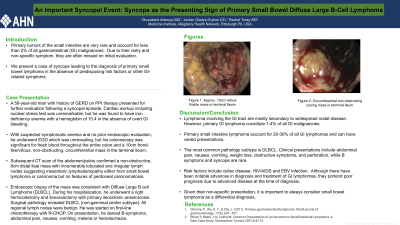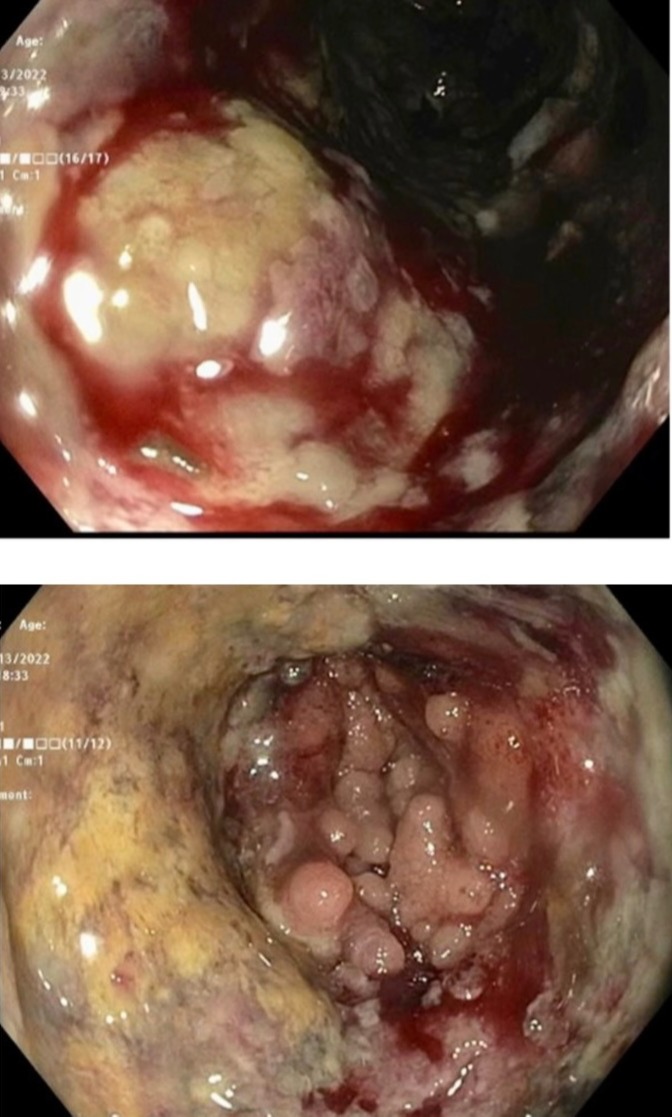Back


Poster Session B - Monday Morning
Category: Small Intestine
B0673 - An Important Syncopal Event: Syncope as the Presenting Sign of Primary Small Bowel Diffuse Large B Cell Lymphoma
Monday, October 24, 2022
10:00 AM – 12:00 PM ET
Location: Crown Ballroom

Has Audio

Oluwakemi Adewuyi, MD
Allegheny Health Network
Pittsburgh, PA
Presenting Author(s)
Oluwakemi Adewuyi, MD, Jordan Gladys-Oryhon, DO, Rachel Toney, MD
Allegheny Health Network, Pittsburgh, PA
Introduction: Primary tumors of the small intestine are very rare and account for less than 2% of all gastrointestinal (GI) malignancies. Due to their rarity and non-specific symptoms, they are often missed on initial evaluation. We present a case of syncope leading to the diagnosis of primary small bowel lymphoma in the absence of predisposing risk factors or other GI-related symptoms.
Case Description/Methods: A 58-year-old man with history of GERD on PPI therapy presented for further evaluation following a syncopal episode. Cardiac workup including nuclear stress test was unremarkable, but he was found to have iron deficiency anemia with a hemoglobin of 10.4 in the absence of overt GI bleeding. With suspected symptomatic anemia and no prior endoscopic evaluation, he underwent EGD which was unrevealing, but his colonoscopy was significant for fresh blood throughout the entire colon and a 10cm frond-like/villous, non-obstructing, circumferential mass in the terminal ileum. Subsequent CT scan of the abdomen/pelvis confirmed a non-obstructive, 8cm distal ileal mass with innumerable lobulated and irregular lymph nodes suggesting mesenteric lymphadenopathy either from small bowel lymphoma or carcinoma but no features of peritoneal carcinomatosis.
Endoscopic biopsy of the mass was consistent with Diffuse Large B cell Lymphoma (DLBCL). During his hospitalization, he underwent a right hemicolectomy and ileocecectomy with primary ileocolonic anastomosis. Surgical pathology revealed DLBCL (non-germinal center subtype). All regional lymph nodes were benign. He was started on first-line chemotherapy with R-CHOP. On presentation, he denied B-symptoms, abdominal pain, nausea, vomiting, melena or hematochezia.
Discussion: Lymphoma involving the GI tract are mostly secondary to widespread nodal disease. However, primary GI lymphomas constitute 1-4% of all GI malignancies. Primary small intestine lymphomas account for 20-30% of all GI lymphomas and can have varied presentations. The most common pathology subtype is DLBCL. Clinical presentations include abdominal pain, nausea, vomiting, weight loss, obstructive symptoms, and perforation, while B symptoms and syncope are rare. Risk factors include celiac disease, HIV/AIDS and EBV infection. Although there have been notable advances in diagnosis and treatment of GI lymphomas, they portend poor prognosis due to advanced disease at the time of diagnosis. Given their non-specific presentation, it is important to always consider small bowel lymphoma as a differential diagnosis.

Disclosures:
Oluwakemi Adewuyi, MD, Jordan Gladys-Oryhon, DO, Rachel Toney, MD. B0673 - An Important Syncopal Event: Syncope as the Presenting Sign of Primary Small Bowel Diffuse Large B Cell Lymphoma, ACG 2022 Annual Scientific Meeting Abstracts. Charlotte, NC: American College of Gastroenterology.
Allegheny Health Network, Pittsburgh, PA
Introduction: Primary tumors of the small intestine are very rare and account for less than 2% of all gastrointestinal (GI) malignancies. Due to their rarity and non-specific symptoms, they are often missed on initial evaluation. We present a case of syncope leading to the diagnosis of primary small bowel lymphoma in the absence of predisposing risk factors or other GI-related symptoms.
Case Description/Methods: A 58-year-old man with history of GERD on PPI therapy presented for further evaluation following a syncopal episode. Cardiac workup including nuclear stress test was unremarkable, but he was found to have iron deficiency anemia with a hemoglobin of 10.4 in the absence of overt GI bleeding. With suspected symptomatic anemia and no prior endoscopic evaluation, he underwent EGD which was unrevealing, but his colonoscopy was significant for fresh blood throughout the entire colon and a 10cm frond-like/villous, non-obstructing, circumferential mass in the terminal ileum. Subsequent CT scan of the abdomen/pelvis confirmed a non-obstructive, 8cm distal ileal mass with innumerable lobulated and irregular lymph nodes suggesting mesenteric lymphadenopathy either from small bowel lymphoma or carcinoma but no features of peritoneal carcinomatosis.
Endoscopic biopsy of the mass was consistent with Diffuse Large B cell Lymphoma (DLBCL). During his hospitalization, he underwent a right hemicolectomy and ileocecectomy with primary ileocolonic anastomosis. Surgical pathology revealed DLBCL (non-germinal center subtype). All regional lymph nodes were benign. He was started on first-line chemotherapy with R-CHOP. On presentation, he denied B-symptoms, abdominal pain, nausea, vomiting, melena or hematochezia.
Discussion: Lymphoma involving the GI tract are mostly secondary to widespread nodal disease. However, primary GI lymphomas constitute 1-4% of all GI malignancies. Primary small intestine lymphomas account for 20-30% of all GI lymphomas and can have varied presentations. The most common pathology subtype is DLBCL. Clinical presentations include abdominal pain, nausea, vomiting, weight loss, obstructive symptoms, and perforation, while B symptoms and syncope are rare. Risk factors include celiac disease, HIV/AIDS and EBV infection. Although there have been notable advances in diagnosis and treatment of GI lymphomas, they portend poor prognosis due to advanced disease at the time of diagnosis. Given their non-specific presentation, it is important to always consider small bowel lymphoma as a differential diagnosis.

Figure: Figure 1: Endoscopic views of large friable villous mass in Terminal Ileum
Disclosures:
Oluwakemi Adewuyi indicated no relevant financial relationships.
Jordan Gladys-Oryhon indicated no relevant financial relationships.
Rachel Toney indicated no relevant financial relationships.
Oluwakemi Adewuyi, MD, Jordan Gladys-Oryhon, DO, Rachel Toney, MD. B0673 - An Important Syncopal Event: Syncope as the Presenting Sign of Primary Small Bowel Diffuse Large B Cell Lymphoma, ACG 2022 Annual Scientific Meeting Abstracts. Charlotte, NC: American College of Gastroenterology.

